How to Photograph Buildings and Interiors: Third Updated and Expanded Edition
Since the previous edition of the much-acclaimed How to Photograph Buildings and Interiors, a great deal has changed in the world of photography. Author Gerry Kopelow, who teaches architectural... This description may be from another edition of this product.
Format:Paperback
Language:English
ISBN:1568983239
ISBN13:9781568983233
Release Date:September 2002
Publisher:Princeton Architectural Press
Length:304 Pages
Weight:2.15 lbs.
Dimensions:0.8" x 8.4" x 11.1"
Grade Range:Grade 8 to Postsecondary
Customer Reviews
4 ratings
A great Inrtoduction to interior and exterior photography
Published by Thriftbooks.com User , 18 years ago
I bought this book about 2 years ago and it still is one of the best written books on architectural photography. The book is written with film in mind, but IT DOES go into some detail about digital photography. To me, it disn't matter if it was film or digital because I shoot digital and was much more interested in the techniques and principles of architectural photography. This book is a complete course. Just about every topic is covered to some extent. It does cover equipment used by the author and other professional arcitectural photographers and why. This topic is covered in good detail. Other topics also incluse things like best persepectives for interior or exterior shots, architeural details (interesting), what publications look for, what potential clients really want and need (enginneers, architects, magazines, etc). The techniques showed and discussed in this book are very useful, even in the digital age. As I write this (Oct. 2006)don't let the fact that this book was written with film mostly in mind deter you. It's about the techniques used that are more important. Transpareny film is still much perferred by all the major architectural magazines and large format cameras are discussed because that is what is being used in Professional Architectural photography. Having said that, I don't use large format cameras (don't know how). My clients are not as particular about correcting distortions as a magaine editor might be. But the proper lighting techniques, camera positions, equipment, etc. do matter. And this book just about covers it all. This book is an easy read and well illustrated with plenty of photographs and diagrams. It would be at an advanced level. If you are looking for a book that tells you how to mimic shots, rather than to explain the key concepts behind shots in order to let you apply this knowledge in a way you prefer, then this book may not be for you. It's not really about "cookie-cutter photography". I'm an experienced semi-professional photographer, with a combination of formal education and several years experience in film and digital photography. I've read many books on photography and this one is very good. I also understand that the author is shooting more digital now and is a Canon Explorer of Light. I hope this helps someone.
A day in the life
Published by Thriftbooks.com User , 19 years ago
This is a fabulous book. It's not an intro to photography, and it won't tell you how to, say, light interiors. Instead, it's strength is in the wealth of detail about the author's daily practices and how individual photos were made, his well-reasoned opinions about equipment, his advice for dealing with editors and architects, and his enthusiasm for the digital future. You'll need to know how a view camera works to get the most from the book.
Breaking into the field
Published by Thriftbooks.com User , 22 years ago
This book is an introduction to architectural photography for professionals and talented amateurs who want to break into the field. It is also intended for architectural firms who would like to designate someone to function as an in-house photographer. The book contains chapters about how to work with a professional photographer, where professional architectural photos can be marketed, and the diary of an architectural photographer when working on a project. In addition, there are chapters on types of cameras, film, lenses, lighting, and where to buy equipment. Aesthetic considerations for architectural photography are covered in a few chapters. The organization tends to jump around a bit- -sometimes it seems like the chapters are presented in an almost random order. The book includes a short section of color plates and a glossary, in addition to the index.This book is intended for people who already have some skill in photography. I like to take pictures of houses as a hobby, and I picked up this book with the hope of learning how to make my pictures look better. After reading the book, I am better able to spot some obvious mistakes in my house photos, but I didn't learn that much that will help me on the hobbyist level- -a book for beginners would have been better for my purposes. On the other hand, professional photographers may find much of interest in this book.
Very Good Book
Published by Thriftbooks.com User , 23 years ago
Gerry Kopelow, in this book, gives lots of helpful hints about the way to shoot astonishing photos of Building and interiors, keeping in mind the main "client" of this kind of photos: Architects, Designers and so on. The most useful hints in this book are the ones about the way you can save money, correctly choosing lights, materials, compositions ... a very good book, both for the beginner and the pro.






